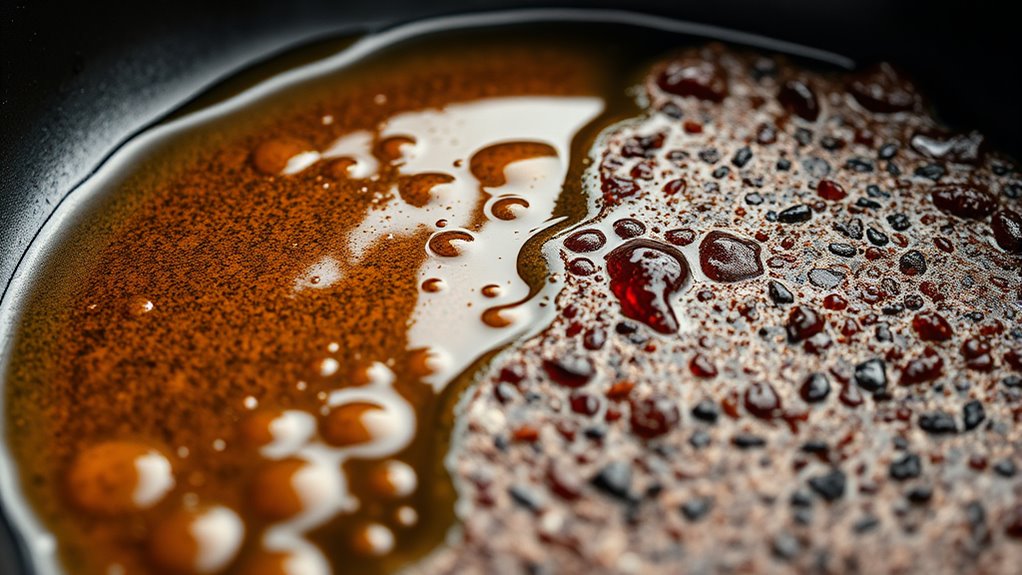The Maillard reaction happens when proteins and sugars combine at around 140°C, creating savory flavors and browning foods like bread and grilled meats. Caramelization, however, occurs above 160°C, breaking down sugars to develop sweet, toasted flavors found in candies and toffee. While the Maillard involves amino acids, caramelization only involves sugars. Understanding these differences helps you control flavor, color, and aroma in your cooking—discover more about how they each influence your dishes.
Key Takeaways
- Maillard reaction involves amino acids and sugars at around 140°C, producing savory, roasted flavors; caramelization involves sugar breakdown above 160°C for sweet, toasted notes.
- Maillard creates complex heterocyclic compounds responsible for savory aromas; caramelization yields rich caramel and toffee flavors.
- Maillard requires proteins and reducing sugars, while caramelization involves only sugar molecules breaking down and recombining.
- The Maillard reaction is pH-sensitive and occurs at lower temperatures, whereas caramelization is driven solely by heat at higher temperatures.
- Maillard enhances color and aroma in baked and grilled foods; caramelization produces characteristic golden-brown color and sweetness.

Have you ever wondered what makes toasted bread or roasted coffee taste so rich and flavorful? The answer lies in complex chemical processes that transform simple ingredients into something extraordinary. Two main reactions are responsible for these flavors: the Maillard reaction and caramelization. Understanding the difference between them helps you appreciate how your favorite foods develop their distinctive tastes and aromas.
Discover how Maillard reaction and caramelization create rich, flavorful foods through unique chemical processes.
The Maillard reaction is a chemical process that occurs when proteins and sugars interact at elevated temperatures. It’s a cornerstone of flavor development in cooking and baking because it creates a broad spectrum of complex, savory flavors and appealing brown hues. This reaction begins around 140°C (285°F) and accelerates as temperatures rise. During this process, amino acids and reducing sugars bond, forming new compounds that produce the roasted, meaty, or toasted flavors you associate with grilled meats, fried onions, and baked bread. The Maillard reaction’s chemical processes generate a wide range of flavor molecules, including heterocyclic compounds, which give foods their characteristic aroma and taste. This reaction is highly sensitive to factors like pH, moisture, and temperature, making it a versatile tool for chefs and food scientists to manipulate flavor profiles.
Caramelization, on the other hand, is a different kind of chemical process that involves the thermal decomposition of sugars. It occurs when sugars are heated to higher temperatures—typically above 160°C (320°F)—causing their molecules to break down and recombine into new, more complex compounds. As sugars caramelize, they turn a rich amber or deep brown color, developing a sweet, buttery aroma. This process is primarily driven by the heat-induced transformation of sugar molecules and doesn’t require proteins to occur. Caramelization produces flavors reminiscent of toffee, caramel candies, and roasted vegetables. Unlike the Maillard reaction, which involves both proteins and sugars, caramelization is a straightforward sugar transformation. Its simplicity allows it to create intense sweetness and a distinct, toasted flavor profile.
Both reactions are essential for creating the depth and richness we love in cooked foods, but they operate through different chemical processes. The Maillard reaction’s flavor development relies on the interaction between proteins and sugars, resulting in savory and roasted notes. Caramelization focuses solely on sugar breakdown, producing sweet, caramelized flavors. Recognizing these differences helps you understand why, for example, a browned steak tastes different from a caramelized onion. By mastering these reactions, cooks and food enthusiasts can better control the flavor, color, and aroma of their dishes, elevating everyday cooking into a culinary art.
Frequently Asked Questions
Can the Maillard Reaction Occur Without Heat?
You might wonder if the Maillard reaction can happen without heat. In fact, Maillard chemistry relies on heat to initiate flavor development, as it involves amino acids and sugars reacting at elevated temperatures. Without sufficient heat, this reaction stalls, and you won’t get the complex flavors associated with it. So, while some minor Maillard chemistry can occur at lower temperatures, the full flavor development generally requires heat to proceed effectively.
Which Sugars Are Involved in Caramelization?
You’re about to discover the secret behind those irresistible caramel flavors! In caramelization, you mainly involve simple sugars like glucose, fructose, and sucrose. When these sugars heat up, they break down and develop rich, complex flavors, transforming into that luscious caramel color and taste. Without these sugar types, you’d miss out on the deep, sweet notes that make caramel so addictive. So, it’s all about heating those sugars just right!
How Does Moisture Affect Each Process?
Moisture influences both processes considerably. In caramelization, high moisture levels slow down the process because water needs to evaporate first, requiring a dry cooking environment for proper browning. Conversely, the Maillard reaction can occur with some moisture present, but excessive water can hinder browning by preventing the temperature from reaching the necessary level. Managing moisture guarantees ideal flavor development in each process, depending on your cooking environment.
Are Both Reactions Safe for Consumption?
Did you know that both the Maillard reaction and caramelization are generally safe for consumption? You might wonder about food safety and toxicity concerns, but these browning processes occur naturally during cooking and don’t produce harmful substances when done properly. However, overcooking or burning can create potentially toxic compounds. So, enjoy your food, but keep an eye on the heat to guarantee safety and avoid any unwanted health risks.
Can These Reactions Happen Simultaneously in Cooking?
Yes, these reactions can happen simultaneously during cooking. As you heat food, both the Maillard reaction and caramelization contribute to flavor development and texture alteration. They often occur together, especially in processes like roasting or frying, creating complex tastes and appealing textures. By understanding this, you can control heat and time to enhance your dishes, ensuring rich flavor and desirable consistency without overdoing either reaction.
Conclusion
Think of the Maillard reaction as a warm, golden sunrise, where proteins and sugars awaken to create rich, savory hues and flavors. Caramelization is like the setting sun, transforming sugars into deep amber treasures with a sweet, smoky glow. Both processes paint your dishes with their unique strokes—one adding complexity, the other sweetness. Understanding these symbols helps you master your kitchen art, turning simple ingredients into vibrant, flavorful masterpieces that tell their own delicious stories.









